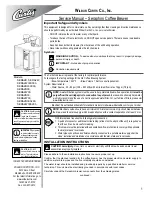
7 PROCEDURE FOR CAG PROCESS
0463 730 001
- 25 -
© ESAB AB 2021
7
PROCEDURE FOR CAG PROCESS
Arc air gouging
For arc air gouging, a special electrode is used comprised of a carbon rod with a copper
casing.
An arc is formed between the carbon rod and the workpiece, which melts the material.
Compressed air is supplied, so the melted material is blown away.
For arc air gouging the power source must be supplemented with:
• ARCAIR torches
• compressed air
• Return cable with clamp
1.
"Recommended voltage setting and groove depth for
2.
Fix the gouging rod in the gouging torch so that the projection of the rod is around 150
mm.
3.
Set the pressure of the compressed air between 80 psi and 100 psi.
4.
Before gouging, ensure the compressed air is pointing toward the work area to ensure
proper blowing.
5.
Set the voltage on the power source by referring to the gouging table in the manual or
on the power source.
6.
Initiate the arc by scratching the metal with the gouging rod.
7.
Maintain the gouging rod at an angle of 30–40 degrees for most of the gouging
application. A steeper angle or lower travel speed may be required when going for a
deep cut.
8.
Maintain a constant travel speed for better performance
9.
After finishing gouging, the groove has to be cleaned or ground for a smooth surface.
NOTE!
To ensure the correct setting for the process, melt the copper coating on the
gouging rod to the same level as the carbon rod.
Electrode size
Groove depth (Min. to Max.) Set voltage
3.2 mm (1/8")
2–3.5 mm
18.5–24 V
4 mm (5/32'')
3.2–4 mm
25–32 V
4.8 mm (3/16'')
3.2–6.4 mm
32–37 V
6.4 mm (1/4'')
3.2–8 mm
33–38 V
7.9 mm (5/16'')
4–9.5 mm
35–41.5 V
9.5 mm (3/8'')
4.8–12.7 mm
35–41.5 V
13 mm (1/2'')
6.4–19 mm
38–45.5 V
Recommended voltage setting and groove depth for ARCAIR Gouging Electrodes















































